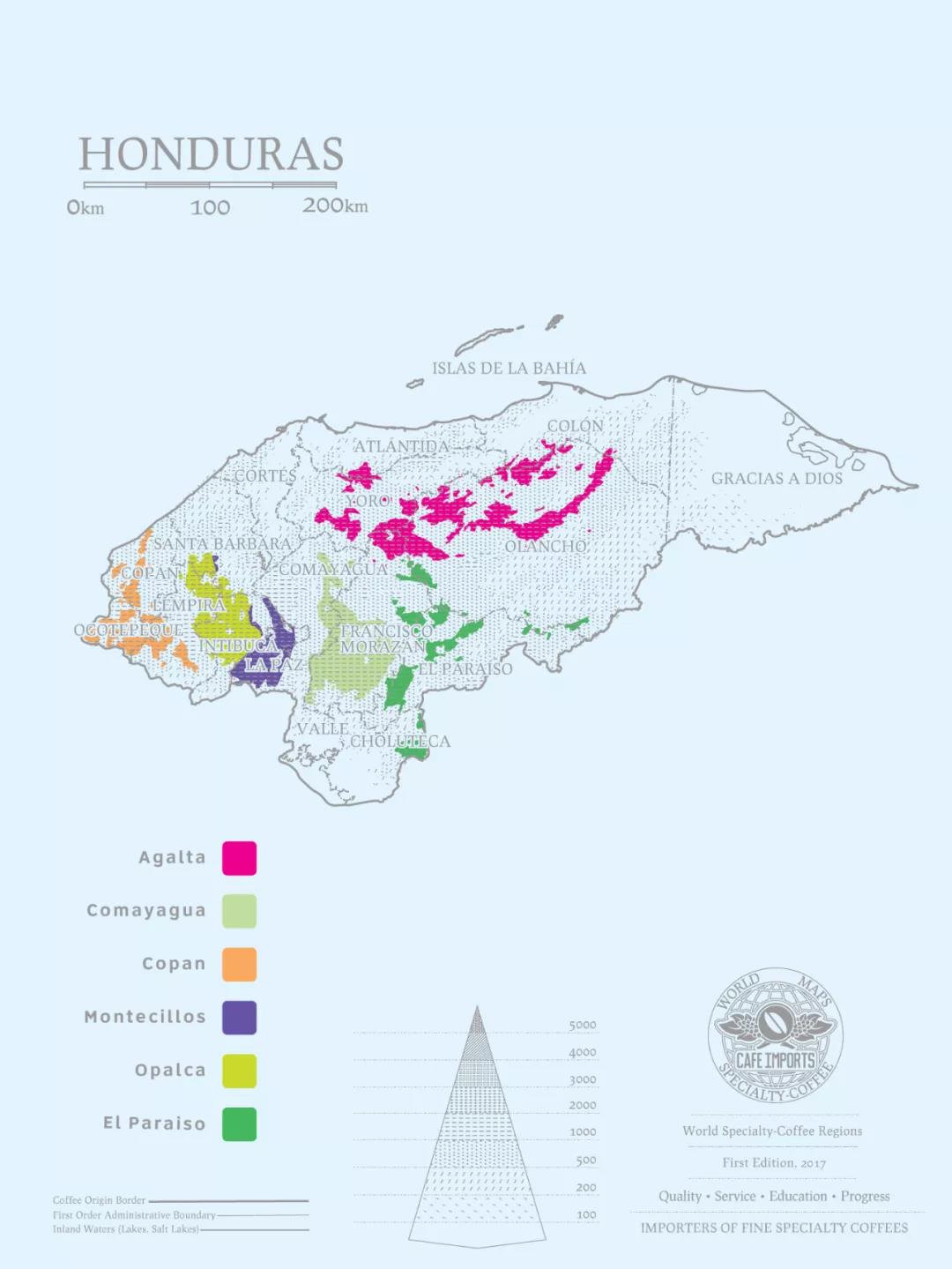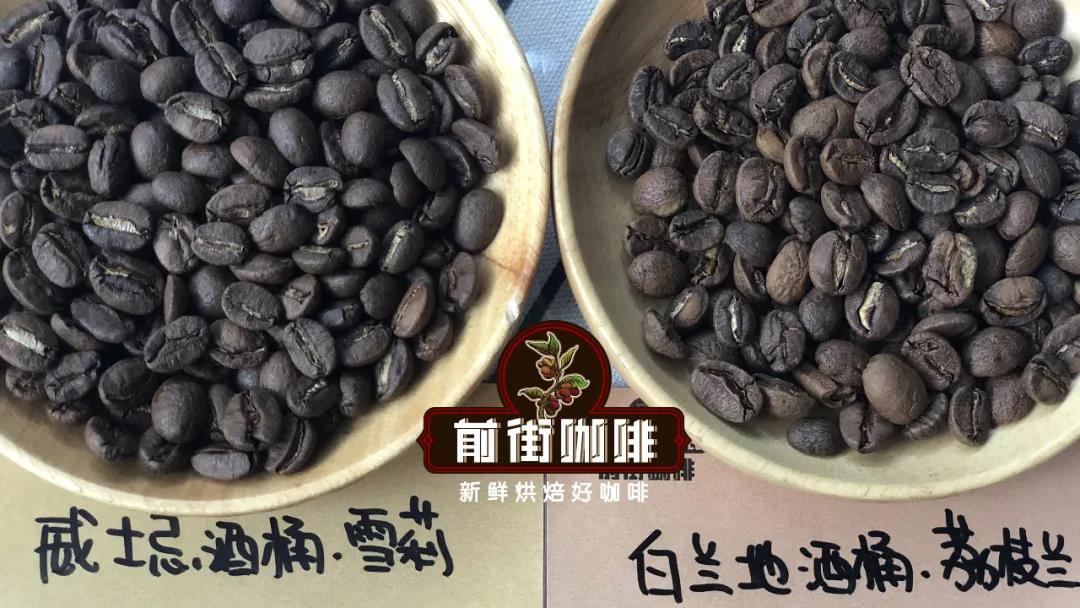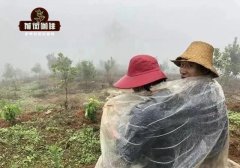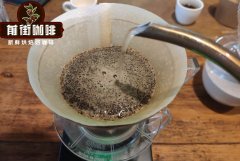Difference of brewing flavor between Shirley coffee beans and litchi orchid coffee beans in Honduras boutique coffee producing area
Professional coffee knowledge exchange more coffee bean information please follow the coffee workshop (Wechat official account cafe_style)
When it comes to Honduran coffee, I believe many enthusiasts will think of that cup of Shirley coffee full of whisky and vanilla cream. Shirley and Litchi orchid, two coffee beans from Honduran barrels on the front street, have always been popular with many enthusiasts. The barrel fermentation treatment of coffee beans can bring unprecedented flavor and taste to coffee beans. Some friends who can't touch alcohol but are curious about whisky can try sherry coffee beans because they are similar to whisky in terms of aroma and smooth taste.
Planting History of Honduras
Honduran coffee was first introduced to Honduras by Spanish merchants in the late 18th century. Coffee was grown on a small scale in Honduras in 1804. In fact, there is a historical reason for the late development of coffee in Honduras, which is due to the lack of transportation construction connecting the producing area and the port in Honduras, which leads to the slow start of the coffee industry in Honduras.
But after 1970, the government created Instituto Hondure ñ o del Cafe (IHCAFE), the official agency for coffee, to improve the quality of coffee, and coffee trees could be planted all over Honduras, allowing Honduras to overtake Costa Rica and Guatemala in coffee production in 2011. In 1975, Frosts Descent, Brazil, coffee production plummeted, while Honduras took the opportunity to "take the top". Coffee production surged from 500000 bags to 1.8 million bags and was looted. It was only after that that coffee production in Honduras really developed.

In 1990, the rise of boutique coffee in Central America, other countries won by quality, while Honduras lagged behind in coffee quality. The main reason is that in the process of raw bean treatment, due to abundant and uncertain rainfall in the mountain area, the final stage of drying is affected. In 2004, for the first time in Honduras, the Zhuoyue Cup Raw Bean Competition was held. 21 coffees from all over the country were recognized and participated in online auctions.
In 2011, Honduras became the highest coffee producer in Central America and the second largest Arabica coffee producer in the world. Today, Honduras has become one of the top ten coffee producers in the world and the second Arabica coffee producer in the world. Coffee has played an important role in its economy and national development. There are 280000 hectares of coffee plantations in Honduras, mainly small coffee plantations, most of which are less than 3.5ha. These coffee plantations account for 60 per cent of all coffee production in Honduras.
Geography of Honduras
Honduras is located in the north of Central America, bordered by Nicaragua and El Salvador in the east and south, and Guatemala in the west, mostly mountains and plateaus, about 1500 meters above sea level, with a tropical climate, with an average temperature of 16 mi 20 ℃ and abundant rainfall, which is conducive to the cultivation of coffee. Coffee in Honduras is grown mainly in a small family model, of which 70% of small farms are less than 2 hectares.

Honduras produces two kinds of coffee of very good quality, which are highly respected by coffee lovers. One is the "Highland Coffee High Grown", which is grown at an altitude of 1000 Muhammad 1500 Michael, and the other is the "selected Highland Coffee Strictily High Grown", which represents the highest level of Honduran coffee, which is grown at an altitude of 1500 Murray 200 meters. Most Honduran coffee is exported to the United States and Germany.
Qianjie has compared the coffee beans of these Chinese and American countries, they all have a common flavor characteristic: flower and fruit aroma and soft fruit juice. Although the flavor of Honduran coffee will be similar to that of neighboring countries, Honduran coffee can feel the elements of exotic spices in the aroma, the latter part will be full-bodied with nut chocolate, and the overall performance will be balanced and layered.
Coffee producing areas of Honduras
Honduran coffee can be divided into five boutique coffee producing areas, mainly located in the western and southern regions of Copan, Opalaca, Montecillos, Comayagua and Agalta Tropical. The average planting height of high-quality products is more than 1100 meters above sea level. 69 per cent of the coffee grown in these areas is HG and 12 per cent is SHG,19% and CS. Of course, there are many small producing areas in front of the street here do not introduce one by one.
Copan: located between Copan, Ocotepeque and Lempira, showing a strong chocolate flavor, characterized by the sweetness of honey and caramel, the fruit flavor is relatively light, planted at 1000-1500 meters above sea level, and the season is from November to March.

Obalaca District (Opalaca): located between Santa B á rbara, Intibuca and Lempira regions, with very fine acidity, overall balance, taste of tropical fruits such as grapes, mulberries, etc., the finish is sour and sweet, showing a strong lemon flavor, neutralized by honey and caramel sweetness, with obvious fruit flavor, 1100-1400 meters above sea level, from November to March.
Montesius (Montecillos): located between the La Paz, Comayagua, Santa B á rbara and Intibuca regions, full of fruity and sweet aromas, with lemon and floral aromas. Lemon and fruit aromas are important features, especially peaches and oranges, with lively and bright acidity, velvety texture and a lingering finish. 1200-1600 meters above sea level, the production season is from December to April.

Gongma Agua (Comayagua): located between Comayagua and Francisco Moraz á n, mainly lemon flavor, obviously sweet fruit aroma, taste more creamy mellow, but also with citrus sweetness, and exudes sweetness and chocolate flavor, 1000-1500 meters above sea level, production season from December to March.
Akata (Agalta Tropical): this region, which spans parts of Olancho, El Paraiso and Francisco Morz á n provinces, is mainly the eastern province and is the most scattered region. It consists of 14 protected areas to increase their plant diversity to balance the ecosystem and is of high ecotourism value. The aroma and aroma of honey, it has a strong citrus flavor and subtle and obvious acidity, and a pleasant finish. 1200-1500 m above sea level.
Grading of Honduran coffee beans
Just now the front street mentioned in Honduran Geography, Highland Coffee and Special Highland Coffee, and SHG and HG mentioned in the introduction of the producing area, which is actually the grading system of Honduran coffee beans.
Strictly High Grown Special Highland Coffee (SHG): more than 1200 meters
High Grown (HG) Highland Coffee: 1000-1200 m
Central Standard (CS) Central Standard: 600m-1000 m
Honduran coffee varieties
Most of the coffee varieties grown in Honduras are Arabica, mainly derived from Kaddura Caturra, Kaduai Catuai and Pacas Pacas.
Kaddura (Caturra), a natural variety of Arabica variety bourbon, was discovered in Brazil in 1937. Its tree is not as tall and shorter as bourbon. Due to inheriting the blood of bourbon, the disease resistance is relatively weak, but the yield is higher than that of bourbon. Although found in Brazil, Kaddura is not suitable for growing in Brazil, so it is not planted on a large scale in Brazil, but is popular in Central and South America, such as Colombia, Costa Rica and Nicaragua. Kaddura is widely planted in Brazil.

Caturra is an artificial hybrid of Kaddura and Mondu Novo. Kaduai has a good ability to resist natural disasters, especially wind and rain. Kaduai tree species are relatively low, compared with other coffee trees, the fruit of Kaduai is stronger and harder to pick. The fruit is both red and yellow. So far, it has not been found that yellow fruit tastes better than red fruit. On the contrary, some people found in the cup test that although the coffee processed by some yellow fruits has good acidity, the cleanliness of the coffee taste is worse than that of the red fruit.

Pacas Pacas was first discovered in 1949 on the estate of the Pacas family. In 1956, some plants with different shapes were found in the bourbon planting area, collected and started breeding research, and William Cogwill, a professor at the University of Florida, was invited to identify them. Identification found that there was a single gene mutation in bourbon planted in Pacas Farm, which caused the plant to become smaller and became a new variety. The new variety is named "Pacas" after the farmer. Pacas's coffee plants are smaller, can be planted more closely, and have higher yields than native bourbon. High-density planting also brings higher yields to farms and performs better in flavor.
Honduran coffee bean treatment
Honduran coffee beans were often washed before the emergence of barrel fermentation.
Coffee farmers first pour the picked coffee berries into a large tank, immature inferior beans will float to the surface, ripe and full fruits will sink to the bottom, and the defective fruits floating on the surface will be removed.

Then use the pulp sieving machine to remove the outer skin and pulp of the coffee fruit, when the coffee beans are still attached to a layer of slippery pectin. Put the coffee beans with pectin in the fermentation tank for 16 hours and 36 hours, during which the microbes will decompose the pectin. After the fermentation is completed, a large amount of water is used to remove the pectin residue from the coffee beans. Finally, the washed coffee beans are dried in the sun.
How did the barrel fermentation method come from?
The Honduran coffee bean wine barrel fermentation method is inspired by the wine fermentation process. During the coffee fermentation process, the barrel can let a very small amount of air through the barrel wall and seep into the barrel to make the coffee beans have a moderate oxidation. The proper amount of oxygen also accelerates the fermentation of coffee.

Smooth tannins, but also let the fresh fruit aroma gradually brew into a rich and changeable ripe wine, the moderate hardness of the barrel to ensure good waterproofing and storage safety, in addition, the barrel contains a certain amount of tannin, when the coffee raw beans in the storage process, the barrel of tannins will also infiltrate into the raw beans inside, so that the coffee has a layered sense and coffee has a strong aroma of wine.
Whisky barrel fermentation and brandy barrel fermentation
In front of the street, the two Honduran wine-flavored bean treatments are carried out around the barrel treatment, and the difference is that they are fermented in different barrels. Shirley and Litchi orchid beans on the front street use delicate washing + whisky sherry barrel / rum barrel fermentation. The freshly picked coffee fruit is carefully washed, then put into a barrel of sherry / rum, fermented at a low temperature for 30-40 days (about 15-20 ℃), and then dried in the shade.

Analysis of raw beans of Qianjie coffee
Two types of beans are refined washing + barrel fermentation, washed beans are blue-green, less silver skin. This is because the washed beans are soaked in the water for a long time, the silver skins are separated from the coffee beans, and the outer silver skins are peeled off by the way when the parchment is finally removed, and there is little silver left on the surface of the washed raw beans.

Experience of coffee baking in Qianjie
Shirley coffee bean roasting: roaster Yangjia 800N (300g) furnace temperature 190 ℃, firepower 140, throttle open 3; tempering point 1 "temperature 39 ℃, throttle open to 4, firepower unchanged; when the furnace temperature is 151.8 ℃, the bean table turns yellow, the grass smell disappears completely, and enters the dehydration stage. When the furnace temperature reaches 150 ℃, the firepower is adjusted to 120, the throttle remains unchanged. The smell of toasted bread has obviously changed to the smell of coffee, which can be defined as a prelude to an explosion. At this time, it is necessary to listen carefully to the sound of the explosion point. The sound of the explosion point begins to explode until the blast starts at 9pm 39th 07, and the throttle opens to 4. After the explosion, the development of 2cm bread 39th ℃ is put into the pot.

Litchi orchid coffee bean roasting: the roaster Yangjia 800N (300g roasting capacity) the furnace temperature is 120℃, the firepower is 140N, the throttle is set up 3; the temperature recovery point is 390 / 32 ", when the furnace temperature is 140℃, the throttle is opened to 4, the firepower is unchanged; when the furnace temperature is 152.6 ℃, the bean table turns yellow, the grass smell disappears completely, and enters the dehydration stage. When the furnace temperature reaches 151℃, the firepower is adjusted to 120and the throttle remains unchanged. The smell of toasted bread has obviously changed to the smell of coffee, which can be defined as a prelude to an explosion. At this time, it is necessary to listen carefully to the sound of the explosion point. The sound of the explosion point starts to explode until the blast starts at 9: 00. The throttle opens to 5, and the development after the explosion is 2: 00. The smell of coffee is obviously changed to 10195 ℃.
Coffee cup test report on Qianjie
Qianjie Coffee will be tested within 8-24 hours after the sample beans are roasted. Qianjie coffee makers generally use the cup test bowl capacity of 200ml ceramic bowl, which will be marked with 150ml and 200ml scale, according to SCAA standards, the TDS of water is about 150ppm, TDs is too low will easily cause over-extraction, too high will affect the taste and easy to lack of extraction, the cup measured the use of water temperature of 94 °. The cup test grinding degree according to the cup test standard of SCAA, the grinding degree is controlled as 20 standard screen (0.85mm), and the passing rate is 70% Mel 75%. Ratio: 11 grams of coffee powder plus 200 milliliters of hot water, that is, 1VR 18.18, so that the concentration of extraction happens to be within the range of 1.15% Murray 1.35% gold cup, soaking time: 4 minutes.
Shirley coffee beans have strong whisky aroma, wet fragrance is vanilla aroma, entrance is whisky aroma, vanilla cream smooth feel, berry acidity, dark chocolate, honey finish.

The dry aroma of litchi orchid coffee beans is vanilla cream, the wet fragrance is litchi, and the entrance is the aroma of brandy, sweet and sour lychee meat, dark chocolate and honey.
Experience of brewing coffee in Qianjie
Filter cup: Hario V60 # 01
Water temperature: 90-91 ℃
Amount of powder: 15g
Powder / water ratio: 1:15
Degree of grinding: medium fine grinding / fine sugar size (80% pass rate of No. 20 screen)

Qianjie coffee is extracted by stages, also known as three-stage brewing: steaming with 30 grams of water for 30 seconds, injecting water around a circle to 125 grams for stages, continuing to inject water to 225 grams when the water level is about to be exposed to the powder bed, and removing the filter cup when all the water levels are about to be exposed to the powder bed. (steaming starts timing) the extraction time is 2 kilogrammes 3900 "- 2 grams 39fixes 10".
Shirley coffee smells of vanilla and cream, with whisky, berries, almonds and dark chocolate in the mouth, with maple sugar in the finish. Litchi orchid coffee entrance litchi, brandy, cream, with the change of temperature, wine and dark chocolate obvious, thick taste, finish honey sweetness is obvious. Although the two types of coffee taste a little similar, but each has its own advantages, those who want to drink with obvious flavor can choose Shirley, and those who want sweet and sour litchi meat can choose litchi orchid.
For more boutique coffee beans, please add private Qianjie coffee on Wechat. WeChat account: kaixinguoguo0925
Important Notice :
前街咖啡 FrontStreet Coffee has moved to new addredd:
FrontStreet Coffee Address: 315,Donghua East Road,GuangZhou
Tel:020 38364473
- Prev

How to brew Yunnan tin card varieties of small-grain coffee beans during the development of Yunnan boutique coffee industry?
Professional coffee knowledge exchange more information about coffee beans Please follow the Coffee Workshop (Wechat official account cafe_style) A movie "coming Home soon" with the theme of Yunnan Coffee was released last month, which sparked discussion in the coffee circle. There are many scenes that resonate with coffee lovers. In the movie, a protagonist describes Yunnan coffee as follows: importing tropical fruits.
- Next

Introduction of Congolese coffee producing areas is Arabica or Robusta?
In the 1970s, the Democratic Republic of the Congo was one of the major coffee exporters in Africa. However, the civil war and political unrest that have continued since the 1990s have had a huge impact on the country's coffee industry. In addition to poverty and disease, conflicts have claimed 6 million lives and displaced thousands in recent years
Related
- Beginners will see the "Coffee pull flower" guide!
- What is the difference between ice blog purified milk and ordinary milk coffee?
- Why is the Philippines the largest producer of crops in Liberia?
- For coffee extraction, should the fine powder be retained?
- How does extracted espresso fill pressed powder? How much strength does it take to press the powder?
- How to make jasmine cold extract coffee? Is the jasmine + latte good?
- Will this little toy really make the coffee taste better? How does Lily Drip affect coffee extraction?
- Will the action of slapping the filter cup also affect coffee extraction?
- What's the difference between powder-to-water ratio and powder-to-liquid ratio?
- What is the Ethiopian local species? What does it have to do with Heirloom native species?

